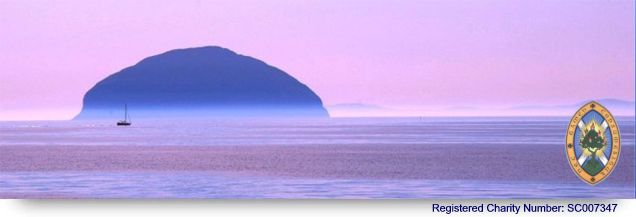
History
The old medieval Kirk of Girvan, which stood in
the Old Street cemetary, was dedicated to St Cuthbert in the 13th
century. After the Reformation of 1560 the Old Kirk continued in use as
a Reformed Church until 1770 when a new kirk was built at the head of
Hamilton Street, now known as Church Square.
When built it was a small rectangular building on a north-south axis
with a central pulpit against the west wall and pews on either side
facing each other. In about 1800 the proprietor of the estate of Bargany
built an addition on the east side, afterwards known as the Bargany
aisle. The church form was now T-plan with three galleries each with its
own entrance.
The internal arrangements were somewhat primitive; the seats were narrow
and very uncomfortable and there was neither session-house nor vestry.
This kirk was demolished in 1884 when the present church was built.
By 1836 the population of Girvan had risen to 5,300
and the congregation had become far too large Old Kirk to accommodate. As a
result a Chapel-of-Ease was erected in 1842. This plain galleried hall was
known as 'The Church on the Green' or 'The Green Kirk'.
 Following the
Disruption of 1843 this kirk was occupied by a Free Church congregation. The
Presbytery of Ayr eventually removed them in 1855. 'The Green Kirk' assumed
full Parish status in 1875 as Girvan South.
Following the
Disruption of 1843 this kirk was occupied by a Free Church congregation. The
Presbytery of Ayr eventually removed them in 1855. 'The Green Kirk' assumed
full Parish status in 1875 as Girvan South.
Deprived of a kirk the Free congregation retired to their school room in
Plumb Square (Chalmer's car park). A new Free kirk, designed by the
architect William Gale, opened in 1857. Following the St Andrew's union in
1947 the kirk was converted to a church hall. It was demolished in the late
1970s.
The Reformed. Presbyterians built a kirk in 1847.
These Cameronians joined the Free Church in 1879.
The kirk is now Stair Park Gospel Hall.
There was evidence of a small dissenting congregation
in Girvan following the first secession of 1733, but they were not
recognised by the Burgher Presbytery of Kilmarnock until 1812. Three years
later their new kirk, an austere little preaching 'box',
 opened in the
Flushes (between Old Street and Bridge Street). Through union with other
18th century seceders these Burghers became United Presbyterians in 1847.
opened in the
Flushes (between Old Street and Bridge Street). Through union with other
18th century seceders these Burghers became United Presbyterians in 1847.
The 19th century was a time of dramatic changes, both in the manner of
worship and the attitude toward the style of church buildings, and the
little kirk in the Flushes was soon considered out of date. A strong desire
for a new U.P. Church was realised in 1870.
A prime site was acquired on the south side of Church Square, opposite the
Old Parish Church and building began early in 1870 to plans by Messrs Clarke
and Bell of Glasgow. The Foundation Stone was laid in March
by George K Young of Glendoune and the Church opened for worship on 25th
September of the same year.
Vacated in 1973, this very attractive kirk was abandoned and was eventually
demolished in 1996.
With a fine new United. Presbyterian church opposite
it was not surprising that there was a strong wish among the Old Parish
congregation for a new, larger, more comfortable church in which to worship.
 In 1882 a petition, signed by members and adherents, which was sent to the
heritors proved successful and architects were invited to submit plans for a
new church. The winners, from a large number of competitors, were the
Glasgow firm of Messrs McKissock and Rowan.
In 1882 a petition, signed by members and adherents, which was sent to the
heritors proved successful and architects were invited to submit plans for a
new church. The winners, from a large number of competitors, were the
Glasgow firm of Messrs McKissock and Rowan.
Building commenced in May 1883 and the Memorial stone was laid by the
Countess of Stair in October of the same year. The church opened for worship
in September 1884.
Following the union of the Free Church 4nd the United. Presbyterians in 1900
the two United Free congregations continued to worship in their own churches
- the U.P. element was known as Trinity and the former Free as Chalmers.
For eighteen years after the union of 1929 the Established Church had four
Parishes in the town. Trinity and Chalmers eventually came together in 1947
to worship in Church Square and Trinity was rechristened St Andrew's.
The final union took place in 1973 when the St Andrew's congregation moved
along Montgomerie Street to worship with the Old congregation to worship
with the Old congregation to become Girven North Parish Church.
Re-produced from "The Presbyterian Kirk in Girvan" 1994
